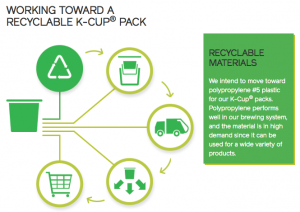A popular headline was floating on my news feed regarding the Keurig K-cups. As someone who doesn’t believe in throwing anything away until it is no longer useful in the foreseeable future (lots of grey area there), disposable and single-use items are the vain of my existence. “Single”-use items are sometimes actually durable enough to be used repeatedly if we were willing to treat them with care as we do with reusable products. Of course, single-serve coffee pods are not.
“K-Cup creator John Sylvan regrets inventing Keurig coffee pod system.”
That’s ironic. 20 years ago he never considered the environmental impact that his invention would have. It’s almost impossible for the consumer to properly recycle K-Cup packages due to their composition. It is difficult to separate the various components for recycling, and there’s no recycling program in place to address this issue even by the manufacturer. You cannot reuse a K-Cup by refilling it with coffee, and K-Cups are made of plastic, which is a petroleum product. This website breaks down the K-Cup life cycle step-by-step to show its environmental footprint. Unfortunately, K-Cups are a popular product and billions of them are sold annually. At least its company, Keurig Green Mountain, pledges to create fully recycable K-Cups by 2020.
Upon exploring the Keurig website, they have taken upon them various sustainability initiatives; sustainable products is just one of them. Their section on sustainability is prominently featured at the top of their website. These pages clearly delineate their green targets and reports relevant statistics and metrics. I encourage you to take a look at the thoroughness of their content and explore the many green programs they are taking on. To me it looks like honest commitment by a company aiming to rectify their coffee pod monstrosities. Having clearly defined goals and devising mechanisms for assessing impact is the first step towards effective monitoring of performance, and documenting those results in reports is the last. Indeed, Keurig produces annual sustainability reports!
While Keurig works hard to clean up its mess, what can current coffee drinkers do to reduce their waste, if quitting isn’t an option? This CBC article suggests some consumer solutions to the coffee pod issue. For example, recyclable and compostable alternatives are being tested and refined by brands called EcoCups and OneCoffee. There’s only 5 more years until 2020. No matter who finishes this race first, it’s a win for Mother Nature.
Source(s):
http://www.carbondiet.ca/green_advice/food/k-cup_coffee_maker_garbage_an_environmental_issue.html
http://www.keuriggreenmountain.com/en/Sustainability/SustainabilityOverview/OurTargets.aspx
http://www.keuriggreenmountain.com/en/Sustainability/ReportsAndDisclosures/Reports.aspx

Hey Vivian, I actually wrote a post about this too! There are other companies who have already created versions of recyclable k-cups but Keurig made a lock out system so other k-cups cannot be used in their machines. Keurig should partner with one of these companies. According to McKinsey’s reasons to create partnerships they already have a clear reason to collaborate and Keurig is in need of professional help. They need to come up with recyclable k-cups to release to the market now and to reduce the amount of waste the company already produces.